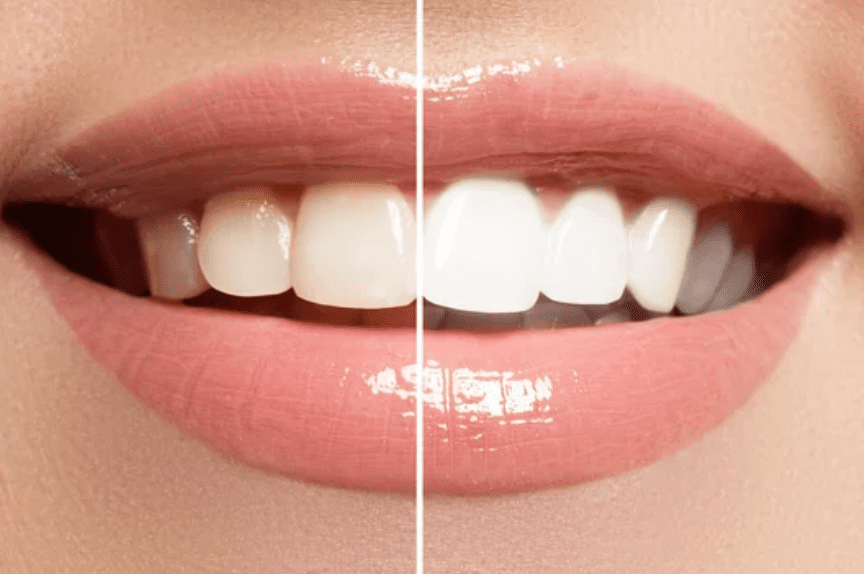Around the new year, many people decide to embark on journeys of personal wellness and gains. It’s the time to change small habits or pieces of ourselves to become better versions of ourselves. An easy way to start the new year with a new you is to try a whitening treatment.

How Does It Work?
Most whitening treatments work the same way with the same chemicals. They target stains on the outer layer of your teeth. Because it is the first layer, its job is to protect the delicate inner portions of your teeth. It’s a whitish layer, so your diet and lifestyle can alter its color easily. For example, smoking cigarettes or drinking coffee every day can cause your teeth to turn yellow.
While some staining isn’t detrimental to your teeth, many people prefer a bright white smile. As a result, they look for different whitening treatments. Many at-home treatments use chemicals to lift the stains from the teeth. Mainly, these chemicals are hydrogen peroxide and carbamide peroxide.
To get rid of stains, these chemicals create a chemical reaction that breaks them down. This is how whitening treatments lift the shade of your teeth; they chemically deconstruct the stains.
Some whitening treatments, like toothpaste, use abrasives to scrub away the stains. When you go to the dentist for a dental cleaning, you get a similar treatment. To polish your teeth, they use a high-powered brush and a gritty toothpaste. You may notice a slight lift in the shade of your teeth.
What are the Effects?
Because whitening treatments use chemicals, you’re likely to experience a range of effects.
Increased Sensitivity
While your enamel is incredibly strong, it is a porous substance. This is how stains can enter your tooth in the first place. These pores allow the peroxide chemicals to break down and lift the stains. Unfortunately, hydrogen peroxide and carbamide peroxide can cause sensitivity in your teeth.
This means that consuming foods or drinks that are hot or cold can cause mild pain or irritation. Normally, the sensitivity won’t last long. It’s a short-term side effect of the whitening chemicals. If you do suffer from sensitivity, you can use a toothpaste formulated for sensitivity.
Gum Irritation
Whitening treatments must remain on your teeth. They’re designed to stay on the enamel, which is the strongest tissue in your body. When the chemicals touch the soft tissues of your gums, they can cause irritation. This can range from redness to sensitivity.
One way to avoid gum irritation is to keep the chemicals from touching your gums. If you do, you should wipe the whitening treatments from your gums as soon as possible.
Bright, White Smile
The negative side effects of whitening treatments are generally mild. This means that they’re unlikely to interrupt your day-to-day life, and they won’t last long.
You will probably notice a brighter, whiter smile over the course of several weeks. Of course, a dazzling white smile is likely the reason that you decided to try a whitening treatment in the first place.
How Long Do Whitening Results Last?
Teeth whitening isn’t permanent, but the results can last a while if you take care of your smile. How long your teeth stay white depends on your habits. If you drink coffee, tea, or red wine often, or if you smoke, the stains may come back faster—sometimes within a few weeks. On the other hand, your whitening results could last several months if you avoid staining foods and drinks and take good care of your teeth.
To keep your smile bright, brush twice a day, floss regularly, and consider using a whitening toothpaste occasionally. Some people also get touch-up treatments every few months to maintain their results.
Natural vs. Chemical Whitening: What’s the Difference?
Not all whitening methods use strong chemicals like peroxide. Some people prefer natural remedies, such as brushing with baking soda or using activated charcoal. These methods work by gently scrubbing away surface stains instead of breaking them down chemically.
However, natural methods are usually less effective than professional or store-bought whitening treatments. They may lighten your teeth slightly but won’t provide the same dramatic results. Also, some natural remedies (like lemon juice) can be acidic and damage enamel if used too often. Talk to your dentist about safe options to get a brighter smile without chemicals.
Can Everyone Whiten Their Teeth?
Whitening treatments work best on natural teeth, but not everyone is a good candidate. For example:
- People with dental work. Dentists can’t whiten crowns, veneers, or fillings, since the materials don’t react to whitening chemicals.
- Those with sensitive teeth or gum disease. Whitening can be too irritating to their teeth and gums.
- Pregnant or breastfeeding women. You should avoid whitening treatments if you’re pregnant, because the effects on babies aren’t fully studied.
If you’re unsure whether whitening is right for you, ask Dr. Trinkner. He can recommend the safest and most effective option for your smile. Call our Columbia, SC, dental team at 803-400-8729 or request a dental visit online when you’re ready.
